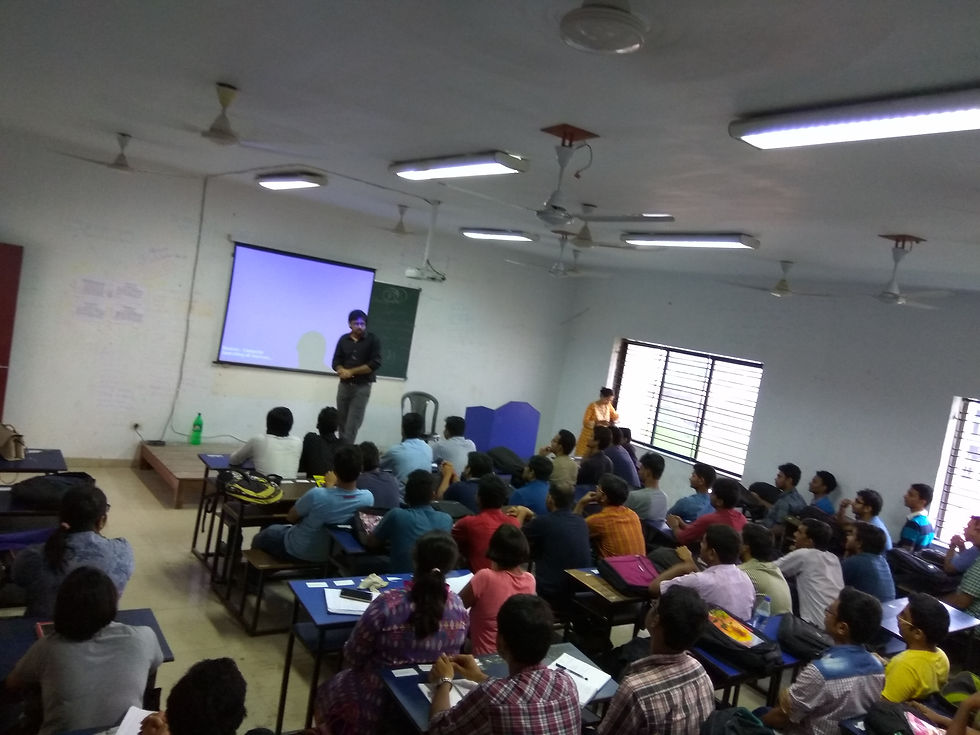Electrical Engineering at ISI: Where Wires Meet Wonders
- iamkoustav28112k
- Aug 9
- 8 min read
Updated: Aug 13

If you thought ISI (Indian Statistical Institute) was just about math and statistics, think again. Sure, the institute is famous for producing number-crunching geniuses and probability wizards, but tucked away in its academic corridors is another world — one filled with buzzing circuits, glowing LEDs, and a faint smell of freshly soldered boards. Welcome to the Department of Electrical Engineering at ISI, where logic meets creativity and theory meets the hum of reality.
Here, wires don’t just tangle randomly — they’re part of intricate systems designed by sharp minds. Microcontrollers, signal processors, and power systems are not just textbook concepts but hands-on projects that students proudly (and sometimes sleep-deprivedly) bring to life. You’ll see future engineers programming algorithms one minute and measuring voltage drops the next — often with a cup of chai somewhere nearby.
What makes Electrical Engineering at ISI truly unique is its fusion of hardcore engineering principles with the institute’s signature analytical precision. You’re not just learning how to build a circuit — you’re learning how to optimise it, model it, and predict its behaviour under different conditions, all backed by rigorous statistical insight. It’s a bit like designing a rocket, but also knowing the exact probability of it landing on Mars instead of your neighbour’s roof.
And yes, while other engineering students might spend hours untangling wires in frustration, ISI’s budding electrical engineers do it with a mix of patience, problem-solving skills, and a strange kind of joy — because here, every tangled wire is just a puzzle waiting to be solved.
Why Electrical Engineering at ISI Is Different
Electrical Engineering at the Indian Statistical Institute isn’t your typical “sit in a massive lecture hall, copy notes, and memorize formulas” kind of experience. It’s a highly personalized, research-driven journey that blends deep technical learning with interdisciplinary insight.
Small Batch Sizes – More Attention, Better LearningUnlike many engineering colleges where you’re just another roll number, ISI keeps its classes intimate. With fewer students per batch, faculty can focus on individual strengths, clarify doubts thoroughly, and mentor you on projects that match your interests.
Interdisciplinary Exposure – Beyond Just CircuitsAt ISI, you won’t be studying electrical engineering in isolation. The program is designed to intersect with fields like statistics, computer science, artificial intelligence, machine learning, and even economics. You’ll understand how electrical systems interact with data, algorithms, and large-scale decision-making — skills that are highly sought after in today’s tech-driven industries.
Research-First Approach – Learning by DoingFrom early in the program, students are encouraged to participate in real-world research projects. By the time you graduate, you might not only have solved challenging engineering problems but also have your name on a published research paper. Yes, it comes with a few late nights and a lot of coffee, but it also builds a strong portfolio for higher studies or industry roles.
What You’ll Study (Besides How to Survive Lab Sessions)
At ISI, Electrical Engineering isn’t just about ticking boxes in a syllabus — it’s about building a deep understanding of both the fundamentals and the futuristic. Your academic journey will include:
Core Electrical EngineeringYou’ll master the pillars of the discipline — from circuits that power everyday electronics to signals that carry information, from electromagnetics that explain how waves travel to control systems that keep machines and processes stable. This is where you learn the “language” every electrical engineer needs to speak.
Electronics & CommunicationStep into the world of semiconductor devices, VLSI design, and wireless networks — the backbone of modern communication systems. You’ll explore how chips are designed, how data travels without wires, and how innovations in communication shape the world.
Interdisciplinary MagicBecause engineering doesn’t live in a silo, you’ll also dive into machine learning, data analytics, and cyber-physical systems — areas where electrical engineering meets AI, big data, and intelligent systems. This crossover prepares you for emerging fields where skills are in high demand.
Project WorkHere, you put theory into action. Whether it’s building a robot that follows you around the lab, creating a smart energy system, or developing a novel communication prototype, project work ensures you graduate with more than just knowledge — you leave with a portfolio of tangible creations.
By the time you finish, you’ll be equally comfortable debugging a circuit, explaining a machine learning algorithm, or impressing people at a hackathon — and yes, you might even become the go-to person for fixing your roommate’s Wi-Fi.
Life at ISI as an Electrical EngineerIt’s not just about wires and waveforms — it’s an entire ecosystem where curiosity meets caffeine.
Long hours in the lab? Absolutely. You’ll find yourself soldering circuits at odd hours, running simulations that test your patience, and relying on the holy trinity of tea, snacks, and playlist playlists to get you through.
The faculty here aren’t just walking encyclopedias — they’re mentors who’ll push you to think deeper, guide you through tricky concepts, and sometimes drop that one hint that saves your project at the last minute.
Your peers? They’re just as passionate, competitive, and (before deadlines) equally exhausted as you. You’ll swap notes, share ideas, and occasionally form alliances to troubleshoot that one stubborn circuit.
Outside the lab, the campus hums with intellectual energy — seminars, research talks, late-night debates over chai. And yes, there might be the occasional power cut, but don’t panic — the UPS will faithfully guard your unsaved work like a silent hero.
By the end, you won’t just graduate with a degree — you’ll carry stories, friendships, and a knack for making things work even when the power doesn’t.
Career & Research OpportunitiesThis is where the tone gets serious — because an Electrical Engineering degree from ISI isn’t just a qualification, it’s a launchpad. The institute’s strong academic reputation, coupled with its industry and research connections, means your post-graduation options are vast:
Join Top-Tier Research Labs — Whether it’s cutting-edge signal processing at DRDO, advanced semiconductor research at IITs, or AI-powered hardware development at global institutions, ISI graduates have a track record of getting into the most competitive labs in India and abroad.
Work in Core Engineering Companies — From power grids and automation to electronics design and embedded systems, you can step into roles where your technical expertise directly drives innovation.
Break into AI, Data Science & Tech Innovation — Thanks to ISI’s interdisciplinary exposure, many graduates seamlessly transition into high-demand fields like machine learning, IoT, robotics, and big data analytics — often blending hardware and software for groundbreaking solutions.
Pursue Higher Studies Worldwide — With a solid foundation and research experience, ISI alumni regularly secure fully-funded positions at prestigious universities like MIT, Cambridge, ETH Zurich, NUS, and beyond. Your ISI credentials often make scholarship committees take notice.
Industry R&D & Startups — The problem-solving mindset you develop here makes you valuable not only to established companies but also to startups pushing the boundaries in green energy, autonomous systems, and wearable tech.
And yes — your ISI tag is like a VIP pass in both academia and industry. It signals not just intelligence, but the resilience, discipline, and curiosity it takes to thrive in one of the most challenging academic environments in the country.
How to Get InSecuring a seat in ISI’s Electrical Engineering program is a challenge — and that’s exactly what makes it prestigious. The institute’s admission process is designed to filter out only the most capable and committed candidates. Here’s what you’re up against:
Entrance Test: ISI conducts a rigorous admission test that assesses your core knowledge in physics, mathematics, and logical reasoning. The questions are designed to test both your conceptual clarity and problem-solving speed. It’s not just about memorizing formulas — it’s about applying concepts to tricky, real-world-style problems.
Competition Level: Thousands apply, but only a select few make the cut each year. Expect the difficulty level to be comparable to (or even higher than) top-tier national exams.
Preparation Strategy: Begin at least a year in advance, focusing on building strong fundamentals. Solve past years’ question papers, take mock tests under timed conditions, and review concepts thoroughly. Logical reasoning is often underestimated — but it can be the deciding factor in your selection.
Interview Round: In some cases, shortlisted candidates may be called for an interview where they are tested on academic depth, clarity of thought, and problem-solving approach.
Final SparkElectrical Engineering at ISI isn’t just another degree — it’s a ticket to joining a league of brilliant minds who drive innovation in science, technology, and research. This program attracts the curious, the ambitious, and those who get more excited about oscilloscopes than Netflix. If you’re passionate about solving problems, building systems, and shaping the future of technology, start preparing now. The competition is fierce, the journey is tough — but the rewards are worth every late-night study session.
Because when you join ISI, you don’t just follow the current — you help create it.
Theorotical based MCQs
1. Which of the following best describes the function of a transformer?
A. Converts electrical energy into mechanical energy
B. Changes the frequency of AC supply
C. Steps up or steps down voltage in an AC circuit
D. Stores electrical energy for later use
Correct Answer: C
Explanation: A transformer works on the principle of electromagnetic induction to change the voltage level of AC without altering the frequency. Step-up transformers increase voltage, while step-down transformers reduce it. It does not convert AC to DC, store energy, or change frequency.
2. What is the primary purpose of an electrical insulator?
A. To conduct electricity efficiently
B. To prevent the flow of electric current
C. To store charge for later use
D. To step up voltage
Correct Answer: B
Explanation: Insulators, such as rubber, glass, and ceramic, are materials that resist the flow of electric current. They are used to protect people and equipment by preventing unwanted current paths.
3. In an electrical power system, the main role of a circuit breaker is to
A. Store electrical energy
B. Increase current flow
C. Automatically disconnect power during faults
D. Reduce voltage fluctuations
Correct Answer: C
Explanation: Circuit breakers protect electrical circuits by automatically switching off the power when they detect overloads, short circuits, or other faults, preventing damage and ensuring safety.
4. Which of the following is a primary advantage of AC over DC for power transmission?
A. AC is cheaper to produce and can be easily transformed to different voltages
B. AC flows only in one direction
C. AC requires less insulation
D. AC can be stored easily
Correct Answer: A
Explanation: AC can be easily transformed to higher voltages for long-distance transmission, reducing power losses. DC cannot be stepped up or down easily without special equipment.
5. The main reason electrical energy is transmitted at high voltages is to
A. Increase the speed of electricity
B. Reduce transmission losses
C. Allow for smaller transformers
D. Prevent lightning strikes
Correct Answer: B
Explanation: High-voltage transmission reduces current for the same power level, which in turn reduces I²R (heat) losses in conductors, making the system more efficient.
6. Which of the following best defines electrical resistance?
A. The ability of a material to store electrical charge
B. The opposition offered to the flow of electric current
C. The ability to transform energy from one form to another
D. The speed at which current flows
Correct Answer: B
Explanation: Resistance is the property of a material that opposes the flow of electric current. It depends on the material, length, cross-sectional area, and temperature.
7. In power plants, the alternator is used to
A. Convert mechanical energy into electrical energy
B. Step up voltage for transmission
C. Control frequency of supply
D. Store electrical energy
Correct Answer: A
Explanation: An alternator generates AC electricity by converting mechanical energy (from turbines) into electrical energy through electromagnetic induction.
8. Which type of motor is most commonly used in household appliances like fans?
A. Synchronous motor
B. DC shunt motor
C. Induction motor
D. Stepper motor
Correct Answer: C
Explanation: Single-phase induction motors are common in household appliances because they are robust, low-maintenance, and operate directly on AC mains supply.
🎯 Why Choose Sourav Sir’s Classes?
✅ Live + Recorded Classes✅ Solved PYQs & Mock Tests✅ Conceptual Teaching for Olympiad-Level Math✅ Doubt Clearing + Personal Mentorship✅ Crash Courses & Full-Year Batches
📍 Visit us at: www.souravsirclasses.com📞 Contact: 9836793076 / 7439021651📧 Email: contact@souravsirclasses.com



_edited.jpg)


































hmining hmining
hmining hmining
hmining hmining
hmining hmining
hmining hmining
hmining hmining
hmining hmining
hmining hmining
hmining hmining
rmcmining rmcmining
rmcmining rmcmining
rmcmining rmcmining
rmcmining rmcmining
rmcmining rmcmining
rmcmining rmcmining
rmcmining rmcmining
rmcmining rmcmining
hmining hmining
hmining hmining
hmining hmining
hmining hmining
hmining hmining
hmining hmining
hmining hmining
hmining hmining
hmining hmining
rmcmining rmcmining
rmcmining rmcmining
rmcmining rmcmining
rmcmining rmcmining
rmcmining rmcmining
rmcmining rmcmining
rmcmining rmcmining
rmcmining rmcmining
hmining hmining
hmining hmining
hmining hmining
hmining hmining
hmining hmining
hmining hmining
hmining hmining
hmining hmining
hmining hmining
rmcmining rmcmining
rmcmining rmcmining
rmcmining rmcmining
rmcmining rmcmining
rmcmining rmcmining
rmcmining rmcmining
rmcmining rmcmining
rmcmining rmcmining
hmining hmining
hmining hmining
hmining hmining
hmining hmining
hmining hmining
hmining hmining
hmining hmining
hmining hmining
hmining hmining
rmcmining rmcmining
rmcmining rmcmining
rmcmining rmcmining
rmcmining rmcmining
rmcmining rmcmining
rmcmining rmcmining
rmcmining rmcmining
rmcmining rmcmining
hmining hmining
hmining hmining
hmining hmining
hmining hmining
hmining hmining
hmining hmining
hmining hmining
hmining hmining
hmining hmining
rmcmining rmcmining
rmcmining rmcmining
rmcmining rmcmining
rmcmining rmcmining
rmcmining rmcmining
rmcmining rmcmining
rmcmining rmcmining
rmcmining rmcmining